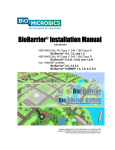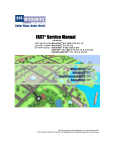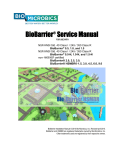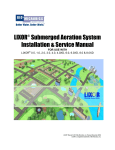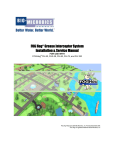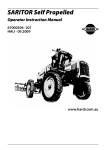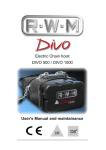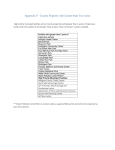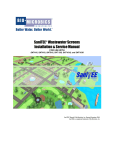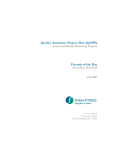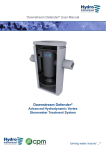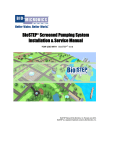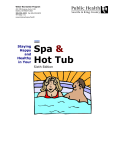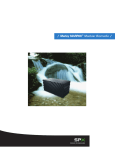Download BioBarrier® Owner`s Manual - Bio
Transcript
BioBarrier® Owner’s Manual FOR USE WITH NSF/ANSI Std. 40 Class I / Std. 350 Class R BioBarrier® 0.5, 1.0, and 1.5 NSF/ANSI Std. 245 BioBarrier® 0.5-N, 1.0-N, and 1.5-N non-NSF/ANSI certified BioBarrier® 2.0, 2.5, and 3.0 BioBarrier® HSMBR® 1.5, 3.0, 4.5, 6.0 and 9.0 BioBarrier Owners Manual © 2013 Bio-Microbics, Inc. Revised September 2013. BioBarrier and HSMBR are registered trademarks of Bio-Microbics, Inc. OWNER’S MANUAL FOR USE WITH ANSI/NSF Std. 40 Class I / Std. 350 Class R BioBarrier® 0.5, 1.0, and 1.5 ANSI/NSF Std. 245 BioBarrier® 0.5-N, 1.0-N, and 1.5-N Non-NSF certified BioBarrier® 2.0, 2.5, and 3.0 BioBarrier® HSMBR® 1.5, 3.0, 4.5 and 9.0 GENERAL INFORMATION The BioBarrier® 0.5, 0.5-N, 1.0, 1.0-N, 1.5 & 1.5-N membrane bioreactor wastewater treatment systems are certified by the NSF International/ American National Standards Institute Organizations to meet NSF/ANSI Standard 40, Class 1 certification for single residence wastewater treatment devices, NSF/ANSI Standard 245 for nitrogen reduction, and NSF/ANSI Standard 350 Class R for restricted indoor and unrestricted outdoor use, such as toilet, urinal flushing and surface and subsurface irrigation. All BioBarrier® products are ETL certified for safety (electrical, environmental, etc.). If you have questions regarding any Bio-Microbics products please contact us at: 800-753-FAST (3278) or (913) 422-0707 e-mail: [email protected] Dear BioBarrier® System Owner Congratulations! You have a BioBarrier® membrane bioreactor wastewater treatment system installed on your property. At the forefront of green technology, the BioBarrier® System by Bio-Microbics meets the highest industry treatment standards. Based on environmentally sound and simple scientific principles, the BioBarrier® process is our continued commitment to improve small onsite treatment capabilities. You can take pride in knowing that, with the BioBarrier® system, you will help ensure a clean environment for future generations. Please take time to read this BioBarrier® Owner’s Manual, you will learn important safety precautions, review detailed information on proper use and care of your system. Designed for minimal operator attention, the BioBarrier® System is designed for the simplicity that the onsite wastewater market requires. By consistently following a maintenance schedule and being mindful of what can go down your drains, you can enjoy the lasting benefits of the BioBarrier® membrane bioreactor wastewater treatment system for decades to come. If you should desire any further assistance, please contact Bio-Microbics at [email protected] or call us at 800-753-3278. Thank you again for using BioBarrier®! Sincerely, Bio-Microbics Team Top things you can do to prolong the life of your system: 1. Have the BioBarrier® system inspected and tank pumped as necessary. 2. Keep track of the substances entering your system, please review the list of Do’s & Don’ts 3. Keep the BioBarrier® System operating - do not turn off the blower. 4. Care for your drain field or irrigation system (if incorporated into your BioBarrier® System). THE BIOBARRIER® SYSTEM The BioBarrier® System, is a membrane bioreactor providing primary settling, fecal coliform, BOD, TSS and nitrogen reduction (if needed) using aeration and anoxic zones, and membrane filtration. The system is contained in locally supplied tanks, either in a two or three compartment tank, or multiple tanks, with the membrane module always in the last compartment/ tank of the system. The membrane module itself consists of flat sheet membranes arranged in a cartridge. A high mixed liquor suspended solids concentration in the aeration zone provides biological treatment and nitrification. The final effluent or permeate is pulled out by the permeate pump through the MBR membranes leaving behind large organic and inorganic particles for further digestion or wasting. If nitrogen removal is not needed the system consists of a tank with two compartments or two separate tanks. The first compartment or tank provides primary treatment - sedimentation and separation of floatables and solids, and is equipped with an outlet screening device called SaniTEE®. From this screened compartment or tank, the wastewater will flow into the second compartment or tank, which is the aeration/membrane zone. H A. Tank C D I B. SaniTEE® C. Blower & Housing F D. Control Panel E E. Vent F. Float Tree B G. BioBarrier Reactor H. Mixing Device (Optional) A G I. Anoxic Baffle Wall (Optional) If nitrogen removal is needed the system consists of a tank with three compartments, or two tanks totaling at least three compartments, with exactly two compartments in the second or final tank. The first compartment or tank provides primary treatment - sedimentation and separation of floatables and solids, and is equipped with an outlet screening device called SaniTEE®. The second and third compartments must be in the same tank, and the second compartment is where denitrification takes place under anoxic conditions. The third compartment, the aeration/membrane zone, is separated from the anoxic zone by a baffle wall between the two zones to allow nitrified waste to enter into the anoxic area for denitrification. NSF Standard 350 Class R Restricted Indoor Urban Reuse Water The BioBarrier® system has been tested under NSF Standard 350 Class R (Residential) and is capable of treating residential wastewater for restricted indoor urban water reuse, which is toilet and urinal flushing. The system design requires a holding tank and plumbing system for reuse water and shall meet all applicable codes; have proper backflow prevention and protection against cross connections; and is the responsibility of the local designer/installer. When the reuse water is used for toilet and urinal flushing, additional disinfection should be considered to provide adequate assurance in preventing microorganism growth in the treated reuse water storage tank and as required by applicable codes. The reuse tank shall be located after the BioBarrier® system. This tank shall also incorporate an overflow that allows excess reuse water to be dispersed in a locally approved soil dispersal system or released into a sanitary sewer system. A potable water make up system shall also be available to supply water when treated reuse water is not available. This potable water make up system shall include a properly designed backflow preventer that meets all applicable codes. NSF Standard 350 Class R Unrestricted Outdoor Urban Reuse Water The BioBarrier® system has been tested under NSF Standard 350 Class R (Residential) and is capable of treating residential wastewater for unrestricted outdoor urban water reuse, which is acceptable for use in surface and subsurface irrigation, including irrigation of edible crops without the edible portion being in direct contact with the treated water. A reuse tank may be required if the irrigation system requires it. The holding tank and plumbing system for reuse water shall meet all applicable codes; have proper backflow prevention and protection against cross connections; and is the responsibility of the local designer/installer. Additional disinfection should be considered to provide adequate disinfection to prevent microorganism growth in the treated reuse water storage tank and as required by applicable codes. If a reuse tank is required for irrigation, it shall be located after the BioBarrier® system. This tank shall also incorporate an overflow that allows excess reuse water to be dispersed in a locally approved soil dispersal system or released into a sanitary sewer system. If a potable water make up system is required for irrigation, it shall include a properly designed backflow preventer that meets all applicable codes. ONGOING SERVICE DO NOT ENTER THE SEPTIC TANK. Hazards exist in a septic system. All precautions must be followed when inspecting the system. Keep tank openings covered at all times. Only authorized service personnel should service a septic system. Lethal gases, high voltage electricity, and other deadly hazards associated with the system. Only qualified service staff should open access ports and/or covers. Infectious organisms exist in a septic tank. If any contact with wastewater, immediately wash and disinfect all exposed areas and contact personal physician. Failure to do so could result in severe sickness or death. The BioBarrier® wastewater treatment system operates automatically and continuously. See SERVICE MANUAL for proper maintenance procedures for the user of the BioBarrier® wastewater treatment system include keeping the vents and the blower housing clear of debris. The homeowner should monitor the status of the system, substances introduced into the system, and the frequency of required pump-out as determined by the service provider. A general evaluation of a BioBarrier® system’s performance can be made using some simple observations which are outlined in the “Trouble Shooting” guide below. Normal operation of the system would include the following: NORMAL OPERATING CONDITIONS The system's blower makes a constant humming noise, much like a household refrigerator. Under normal conditions, the blower should last 5+ years without need for replacement. If an unusual noise is heard, refer to the Trouble-Shooting Guide. A musty, earthy-type of odor is normal. However, if a sewage odor (rotten egg smell) is detected, refer to the Trouble-Shooting SMELL Guide. A properly loaded and operated BioBarrier® system will produce effluent that looks like tap water. If the effluent is turbid, opaque, SIGHT or suddenly changes, refer to the Trouble-Shooting Guide. performed on your NSF certified system, or not all of the items INTRODUCING SUBSTANCES INTO THE SYSTEM: While are checked, please call Bio-Microbics toll-free at 800-753-3278 the FAST® wastewater treatment system will process most or (913)422-0707. waste produced by the average household, introducing large amounts of subatances into the system may reduce the ONGOING SERVICE efficiency of the system or stop the treatment process by Continual service (or extended service for NSF certified systems destroying the biomass. These substances can be grouped as: beyond the first two years) is available and may be purchased prohibited substances and limited-use substances. Please refer through your local Bio-Microbics distributor or current service to the “DO’S AND DON’TS” list to get familiar with provider. This service policy should provide the same services What You Can Put Down the Drain to maximize the system’s as the initial NSF service policy, and perform any additional efficiency and reduce the time period between septic tank service that may be required by local regulation. pump-outs. SEASONAL/INTERMITTENT USE PROPERTIES IN GENERAL: If a substance is harmful to humans or is antiThe BIOBARRIER® wastewater treatment system will function biotic in nature, it should not be put into any septic system normally even if wastewater does not enter the system for an including BioBarrier®. If you have a question regarding the extended period of time. The power to the system should be left effect of a particular substance on the BioBarrier® system, call on during short periods when there is no wastewater flow to the your Bio-Microbics service technician system. Suggestions for intermittent use (Check with local regulations before attempting): If the property is going to be NSF CERTIFIED SYSTEMS SERVICE POLICY used seasonally and shut down completely for an extended All NSF Standard 40, Class 1 certified wastewater treatment period of time (e.g. summer use only and then abandoned for systems (BioBarrier® 0.5, 1.0, 1.5) have an initial service the winter), we suggest that the BioBarrier system be shut agreement for two years (two calls per year) included with the down. The system should be re-started upon return to the system’s initial purchase price. This service is performed by the property. Your local service provider may be contacted to company listed on the blower housing or control panel label. perform this operation. If the property will be used on weekends The NSF service calls ONLY cover NSF Standard 40 certified only, it is best to leave the system ON continuously throughout systems. Other components of the septic system are NOT the season for use until an extended period of absence is covered. anticipated (extended period being at least 3 weeks or more). A During an NSF service call, the service company shall inspect slight odor may be detected for a couple of days while the the blower for proper operation, visually inspect the system’s system returns to normal operation. effluent for clarity, clean the blower intake and assure proper function of the control panel. If these service calls are not SOUND BioBarrier® DO’S AND DON’T’S – What can I put down the drain? Please refer to the list below for important information on how to help keep your treatment system performing as it should. Regular Maintenance should be performed by a qualified service company for ensuring the long life of your system. DON’T PUT THESE ITEMS DOWN THE DRAIN FOOD WASTES ANIMAL BONES / EGG SHELLS COFFEE GROUNDS / CORN COBS FRUIT PEELS & RINDS SKIN / HOME BREWERY WASTE PERSONAL CARE PRODUCTS BANDAGES / CONDOMS DISPOSABLE DIAPERS SANITARY NAPKINS WET WIPES CHEMICALS/TOXINS AUTOMOTIVE FLUIDS CAUSTIC CLEANERS HARSH DETERGENTS FLOOR STRIPPER HERBICIDES / PESTICIDES MEDICATIONS / DRUGS PAINTS - OIL-BASED QUATERNARY AMMONIA SOLVENTS / THINNERS OTHER PRODUCTS CAT LITTER CIGARETTE BUTTS CLOTH TOWELS / RAGS FILM DEVELOPING WASTE METAL / PLASTIC OBJECTS MODELING CLAY PAPER TOWELS / SCRAPS PLASTIC BAGS RV WASTE STRING / YARN / NYLON STICKS / YARD WASTE RECORD KEEPING DISINFECTANTS / CLEANERS Keep copies of all system drawings/plans of the site/installed equipment/service records with all other home appliance documents. Record all applicable information. Use citric acid, chlorine, and/or other biodegradable cleaners according to the manufacturer’s recommendations. Products containing quaternary ammonia or pine oil-based cleaners should not be used. Use drain cleaners as a last resort to unclog pipes. LAUNDRY/WATER USAGE Spread wash loads throughout the week. Instead of liquid fabric softener, dryer sheets should be used. Use low-suds, biodegradable and low phosphate ® detergents, like Mighty Mike from Scienco/FAST (www.sciencofast.com). MEDICINES Large quantities of water are added to your wastewater system when you have leaking fixtures. Timely detection and repair can help to maximize the life of your system, especially the drain field. DO NOT FLUSH THEM DOWN ANY DRAIN. All antibiotic medicines are harmful to treatment quality. Unused medications should be returned to the pharmacy, doctor, or thrown away in the trash. NOTE: As the human body absorbs ≤20% of these medications, please notify your service provider of medicines in the house. This could reduce troubleshooting efforts and possibly your maintenance bill. WATER SOFTENERS SEPTIC TANK ADDITIVES / ENZYMES The process may tolerate discharge from properly operating softeners that backwash as needed based on water usage (DIR) vs. timer operated systems, if allowed by your local regulatory authority. However, these discharges can possibly damage other parts of the septic system. The wastewater in the system contains all the required bacteria for proper operation. Additives are unnecessary; and may do more harm than good. LEAKY FIXTURES FOOD WASTES Garbage disposal waste is acceptable - if allowed by your local regulatory authority. However, it may lead to more frequent removal of solids from your septic tank. For large quantities of food, please dispose of in the garbage. FATS, OILS, & GREASE Be aware grease (i.e. animal fats, vegetable oils, lard, etc) down the drain may overload or prevent the bacteria from fully breaking down the waste. DRAINS FROM GARAGE/WORKROOMS Should be diverted away from your septic system. Items like petroleum-based oils, gas, and saw dust should never enter the system. PAPER PRODUCTS Use single- or double-ply, non-quilted, white toilet paper products. Some color dyes in the paper cannot be eaten by natural bacteria. Non-bleached paper (brown in color) takes longer to break down and can therefore increase your biosolids pump out frequency. Avoid flushing paper towels, napkins, wipes, or other thicker paper material. PLEASE BE AWARE OF THE FOLLOWING - failure to do so could result in severe sickness or death: Only qualified service persons should open any access port on a septic system. Always secure all access covers of the tank, control panel and blower, so that people cannot enter without the use of proper tools. Gases emanating from septic tanks can explode if ignited and is deadly if inhaled. DO NOT use flame or spark near a septic tank access points and never enter the septic tank. Infectious organisms exist in a septic tank. Persons coming in contact with wastewater must immediately wash and disinfect all exposed areas and contact their personal physicians. DO’S AND DONT’S – in the yard Always secure all access covers in place so that people cannot enter the tank, control panel or blower without the use of proper tools. DO NOT use flame or spark near a septic tank’s access points. Gasses emanating from septic tanks can explode if ignited or deadly if inhaled. Only qualified service persons should open any access port or cover on the system. Hazards such as electric shock and Infectious organisms exist in these areas. Persons coming in contact with wastewater, must immediately wash and disinfect all exposed areas and contact your personal physician. Failure to do so could result in severe sickness or death. BLOWER OPERATION ALARM DO NOT turn off the blower for periods longer than 30 minutes. Treatment quality and drain field life could be reduced. If the blower appears to be functioning improperly, reference the Trouble Shooting guide in this manual. If the property is being vacated for an extended period (> 3 weeks), see the section of this manual titled “Intermittent Use”. The alarm may be silenced using the “RESET” button on the panel’s front. Service assistance may be obtained from the local Bio-Microbics distributor or Bio-Microbics, Inc. Information located on the control panel labels may be required to obtain accurate assistance. DOWN SPOUTS Anywhere water is collected, i.e. roof downspouts, pavement runoff, or sump pump/house footing drains, the water should be diverted away from the septic tank or drainfield. VENTS / INTAKES Keep the BioBarrier® system’s vent clear of debris such as leaves and snow. Do not allow the blower housing louvers to become blocked with any debris. Clean the blower’s inlet filter at least annually. STRUCTURES TRAFFIC / LANDSCAPING Do not drive over any portion of your system (tank, piping, drain field) except for normal yard traffic, i.e. lawn mowers, etc. Tanks (H20) can be made for under roadways, driveways. If possible, deter traffic by using a fence or create a landscaped area with shallow root plants (ornamentals, bushes, decorative grasses, and/or flowers). Don’t plant trees near any portion of your system (within 30’). NSF Certified to NSF/ANSI Std 40 Certified to NSF/ANSI Std 245 Certified to NSF/ANSI Std 350 Class R Do not build patios, carports, or other structures over any part of your septic system; as this may cause damage. BIOSOLIDS (SLUDGE) REMOVAL To determine when pump out is required; a maintenance provider should measure the biosolids in the tank(s) on a regular basis. Please see the service manual for specific procedures. NSF® INTERNATIONAL CERTIFIED SYSTEMS SERVICE POLICY All NSF (National Sanitation Foundation)/ANSI Standard 40 Class I / Standard 245 / Standard 350 Class R certified wastewater treatment systems (BioBarrier® 0.5, 0.5-N, 1.0, 1.0-N, 1.5, 1.5-N) have an initial two-year service agreement included with the system’s initial purchase price (two service calls per year). The NSF service calls ONLY cover NSF certified systems; other components of the septic system are NOT covered. If there are any deficiencies in the BioBarrier® system’s operation or components, the service person will notify the owner in writing and detail when these deficiencies can be fixed. The company listed on the blower housing or control panel label performs this service. During an NSF service call, the service company shall inspect the blower for proper operation, visually inspect the system’s effluent for clarity, clean the blower air filter and assure proper function of the control panel. If these service calls are not performed on your NSF certified system, or not all of the items are checked, please call Bio-Microbics at: 800-753-FAST(3278) or (913)422-0707 For continual service of NSF certified systems beyond the first two years, an extended service agreement is available through your local Distributor or current service provider. This policy should provide the same services and may include any additional services that are required by local regulation. LIMITED WARRANTY BioBarrier® Bio-Microbics, Inc. warrants every new residential system against defects in materials and workmanship for a period of two years after installation or three years from the date of shipment, subject to the following terms and conditions, and commercial BioBarrier HSMBR® system for a period of one year after installation or eighteen months from date of shipment, whichever occurs first, subject to the following terms and conditions: During the warranty period, if any part is defective or fails to perform as specified when operating at design conditions, and if the equipment has been installed and is being operated and maintained in accordance with the written instructions provided by Bio-Microbics, Inc., Bio-Microbics, Inc. will repair or replace at its discretion such defective parts free of charge. Defective parts must be returned by owner to Bio-Microbics, Inc.’s factory postage paid, if so requested. The cost of labor and all other expenses resulting from replacement of the defective parts and from installation of parts furnished under this warranty and regular maintenance items such as filters or bulbs shall be borne by the owner. This warranty does not cover general system misuse, aerator components which have been damaged by flooding or any components that have been disassembled by unauthorized persons, improperly installed or damaged due to altered or improper wiring or overload protection. This warranty applies only to the treatment plant and does not include any of the house wiring, plumbing, drainage, septic tank or disposal system. Bio-Microbics, Inc. reserves the right to revise, change or modify the construction and/or design of the BioBarrier® system, or any component part or parts thereof, without incurring any obligation to make such changes or modifications in present equipment. Bio-Microbics, Inc. is not responsible for consequential or incidental damages of any nature resulting from such things as, but not limited to, defect in design, material, or workmanship, or delays in delivery, replacements or repairs. THIS WARRANTY IS IN LIEU OF ALL OTHER WARRANTIES EXPRESSED OR IMPLIED. BIO-MICROBICS SPECIFICALLY DISCLAIMS ANY IMPLIED WARRANTY OF MERCHANTABILITY OR FITNESS FOR A PARTICULAR PURPOSE. NO REPRESENTATIVE OR PERSON IS AUTHORIZED TO GIVE ANY OTHER WARRANTY OR TO ASSUME FOR BIO-MICROBICS, INC., ANY OTHER LIABILITY IN CONNECTION WITH THE SALE OF ITS PRODUCTS. Contact your local distributor for parts and service. SERVICE AFTER THE FIRST TWO YEARS An Extended Service Policy is available and may be purchased through your local Bio-Microbics distributor. The extended service policy should provide the same service checks as the initial NSF service policy, sludge accumulation levels in the septic and FAST tanks, and perform any additional service required by local regulation. Extended service on NSF certified systems should be performed twice per year. BioBarrier ID







